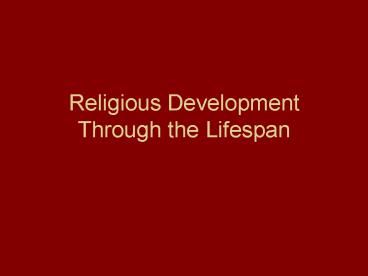Religious Development Through the Lifespan - PowerPoint PPT Presentation
1 / 14
Title:
Religious Development Through the Lifespan
Description:
Capacity for discernment and judgment. Adequate Balance of. Autonomy and Dependence ... Discernment and Judgment. Kolhberg's Stages of Moral Development. 1. ... – PowerPoint PPT presentation
Number of Views:210
Avg rating:3.0/5.0
Title: Religious Development Through the Lifespan
1
Religious Development Through the Lifespan
2
Religious Development
- Religious experience and commitments change over
time. - Often in predictable, consistent ways
- How and why changes occur (or dont occur) are
the essential questions to those studying
religious development
3
Lifespan Development
- Erikson
- Stages of Psychosocial Development
- Handout
- Overview of developmental thinking in
psychology - Relation to the development of personal religious
commitment and spirituality
4
Necessary Elements forReligious Development
- Adequate (healthy) balance of autonomy and
dependence - Capacity for complex thought
- Capacity for discernment and judgment
5
Adequate Balance ofAutonomy and Dependence
- Application of Eriksons stages
- Social Learning Theory
- Reinforcement, punishment, and modeling
- Attachment Theory
- Safe haven and secure base
6
Capacity for Complex Thought
- Piagets Stages of Cognitive Development
- Preoperational (ages 2-7)
- Perception equals reality
- Concrete Operational (ages 7-11)
- Logic and reason is applied to the concrete
- Formal Operational (ages 11-beyond)
- Ability to think abstractly and conceptually
7
Capacity for Complex Thought
- Applications to religious development
- Necessary but not sufficient
- Illustration of individuals with mental
limitations (study by Bassett et al., 1994)
8
Capacity for Complex Thought
- Elkinds Theory of Religious Development
- Changing cognitive ability corresponds with
changing mental needs. - Stages identified by the Search for . . .
9
Capacity for Complex Thought
Search for . . .
Comprehension
Relation
Representation
Conservation
0 5 10 15 20 25 30 . . .
Age
10
Capacity forDiscernment and Judgment
- Kolhbergs Stages of Moral Development
- 1. Preconventional
- Emphasis on external control
- 2. Conventional
- Emphasis on pleasing others
- 3. Postconventional
- Acknowledgement of conflict and internal choice
- Gilligans alteration to correct for sex bias.
11
Theories of Religious Development
- Fowlers Stages of Faith
- What is faith?
- Faith is the relation of trust in and loyalty
to the transcendent about which concepts and
propositionsbeliefsare fashioned. (p.11) - Fowler was interested in how the form and
function of this type of faith evolved or
developed over time.
12
Fowlers Stages
- Primal, Undifferentiated Faith
- (trust through separation)
- Intuitive-Projective
- imaginative fears without logic
- Mythic-Literal
- logic applied concretely and literally
- Synthetic-Conventional
- demand for allegiance grows, is governed by a
mutually held system of values
13
Fowlers Stages
- 4. Inductive-Reflective
- individual values develop as a result of a
willingness to explore self and worldview, often
demythologizing symbols are understood
rationally - 5. Conjunctive
- paradox, developed second naivete, symbols are
reunited with conceptual meaning, conscious
openness to the strange truths of others. - 6. Universalizing
- oneness with the ultimate or with all of life,
power to transform the injustices of the world
14
Summary of Religious Development
- Necessary elements of religious development.
- An example of theory/research related to each
element. - Fowlers Stages of Faith
- What is faith?
- What do the stages describe?































